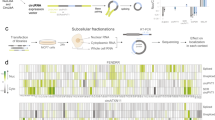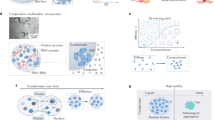Abstract
The biogenesis of the many functional compartments contained in the mammalian cell nucleus is poorly understood. More specifically, little is known regarding the initial nucleation step required for nuclear body formation. Here we show that RNA can function as a structural element and a nucleator of nuclear bodies. We find that several types of coding and noncoding RNAs are sufficient to de novo assemble, and are physiologically enriched in, histone locus bodies (with associated Cajal bodies), nuclear speckles, paraspeckles and nuclear stress bodies. Formation of nuclear bodies occurs through recruitment and accumulation of proteins resident in the nuclear bodies by nucleating RNA. These results demonstrate that transcription is a driving force in nuclear body formation and RNA transcripts can function as a scaffold in the formation of major nuclear bodies. Together, these data suggest that RNA-primed biogenesis of nuclear bodies is a general principle of nuclear organization.
This is a preview of subscription content, access via your institution
Access options
Subscribe to this journal
Receive 12 print issues and online access
$209.00 per year
only $17.42 per issue
Buy this article
- Purchase on Springer Link
- Instant access to full article PDF
Prices may be subject to local taxes which are calculated during checkout





Similar content being viewed by others
References
Lamond, A. I. & Spector, D. L. Nuclear speckles: a model for nuclear organelles. Nat. Rev. Mol. Cell Biol. 4, 605–612 (2003).
Handwerger, K. E. & Gall, J. G. Subnuclear organelles: new insights into form and function. Trends Cell Biol. 16, 19–26 (2006).
Misteli, T. Beyond the sequence: cellular organization of genome function. Cell 128, 787–800 (2007).
Shaw, P. J. & Jordan, E. G. The nucleolus. Annu. Rev. Cell Dev. Biol. 11, 93–121 (1995).
Bongiorno-Borbone, L. et al. FLASH and NPAT positive but not Coilin positive Cajal bodies correlate with cell ploidy. Cell Cycle 7, 2357–2367 (2008).
Misteli, T., Cáceres, J. F. & Spector D. L. The dynamics of a pre-mRNA splicing factor in living cells. Nature 387, 523–527 (1997).
Hall L. L., Smith, K. P., Byron, M. & Lawrence, J. B. Molecular anatomy of a speckle. Anat. Rec. A. Discov. Mol. Cell Evol. Biol. 288, 664–675 (2006).
Valgardsdottir, R. et al. Structural and functional characterization of noncoding repetitive RNAs transcribed in stressed human cells. Mol. Biol. Cell 16, 2597–2604 (2005).
Clemson, C. M. et al. An architectural role for a nuclear noncoding RNA: NEAT1 RNA is essential for the structure of paraspeckles. Mol. Cell 33, 717–726 (2009).
Sasaki, Y. T. et al. MENε/β noncoding RNAs are essential for structural integrity of nuclear paraspeckles. Proc. Natl Acad. Sci. USA. 106, 2525–2530 (2009).
Sunwoo, H. et al. MEN ε/β nuclear-retained non-coding RNAs are up-regulated upon muscle differentiation and are essential components of paraspeckles. Genome Res. 19, 347–359 (2009).
Chen, L.-L. & Carmichael, G. G. Altered nuclear retention of mRNAs containing inverted repeats in human embryonic stem cells: functional role of a nuclear noncoding RNA. Mol. Cell 35, 467–478 (2009).
Kaiser, T. E., Intine, R. V. & Dundr, M. De novo formation of a subnuclear body. Science 322, 1713–1717 (2008).
Dundr, M. et al. Actin-dependent intranuclear repositioning of an active gene locus in vivo. J. Cell Biol. 179, 1095–1103 (2007).
Marzluff, W. F., Wagner, E. J. & Duronio, R. J. Metabolism and regulation of canonical histone mRNAs: life without a poly(A) tail. Nat. Rev. Genet. 9, 843–854 (2008).
Cioce, M. & Lamond, A. I. Cajal bodies: a long history of discovery. Annu. Rev. Cell Dev. Biol. 21, 105–131 (2005).
Matera, A. G. et al. Nuclear bodies: random aggregates of sticky proteins or crucibles of macromolecular assembly? Dev. Cell 17, 639–647 (2009).
Erkmann, J. A. et al. Nuclear import of the stem-loop binding protein and localization during the cell cycle. Mol. Biol. Cell 16, 2960–2971 (2005).
Mandel, C. R., Bai, Y. & Tong, L. Protein factors in pre-mRNA 3′-end processing. Cell. Mol. Life. Sci. 65, 1099–1122 (2008).
Huang, S. & Spector, D. L. Intron-dependent recruitment of pre-mRNA splicing factors to sites of transcription. J. Cell Biol. 133, 719–732 (1996).
Biamonti, G. & Caceres, J. F. Cellular stress and RNA splicing. Trends Biochem. Sci. 34, 146–153 (2009).
Alastalo, T. P. et al. Formation of nuclear stress granules involves HSF2 and coincides with the nucleolar localization of Hsp70. J. Cell Sci. 116, 3557–3570 (2003).
Valgardsdottir, R. et al. Transcription of Satellite III non-coding RNAs is a general stress response in human cells. Nucleic Acids Res. 36, 423–434 (2008).
Frey, M. R. & Matera, A. G. RNA-mediated interaction of Cajal bodies and U2 snRNA genes. J. Cell Biol. 154, 499–509 (2001).
Carmo-Fonseca, M., Ferreira, J. & Lamond, A. I. Assembly of snRNP-containing coiled bodies is regulated in interphase and mitosis—evidence that the coiled body is a kinetic nuclear structure. J. Cell Biol. 120, 841–852 (1993).
Bubulya, P. A. et al. Hypophosphorylated SR splicing factors transiently localize around active nucleolar organizing regions in telophase daughter nuclei. J. Cell Biol. 167, 51–63 (2004).
Fox, A. H., Bond, C. S. & Lamond, A. I. P54nrb forms a heterodimer with PSP1 that localizes to paraspeckles in an RNA-dependent manner. Mol. Biol. Cell 16, 5304–5315 (2005).
Leung, A. K. et al. Quantitative kinetic analysis of nucleolar breakdown and reassembly during mitosis in live human cells. J. Cell Biol. 166, 787–800 (2004).
Hu, Y. et al. Large-scale chromatin structure of inducible genes: transcription on a condensed, linear template. J. Cell Biol. 185, 87–100 (2009).
Acknowledgements
We thank A. Belmont, M. Carmo-Fonseca, C. Clemson, V. De Laurenzi, A. Fox, J. Gall, M. Hastings, R. Intine, P. Kalab, A. Lamond, G. Matera, T. Misteli, D. Spector, E. Wagner and J. Zhao for reagents. We are particularly grateful to T. Misteli for helpful suggestions and critical reading of the manuscript and to V. Barr for help with the fast-spinning disc confocal microscope system. This research was supported by a Schweppe Career Development Award (the Schweppe Foundation) to M.D. and by startup funds from the Rosalind Franklin University of Medicine and Science to M.D.
Author information
Authors and Affiliations
Contributions
M.D. and S.P.S. conceived and designed the experiments. S.P.S. and M.D. performed the experiments and analysed the data. M.D. wrote the paper.
Corresponding author
Ethics declarations
Competing interests
The authors declare no competing financial interests.
Supplementary information
Supplementary Information
Supplementary Information (PDF 1223 kb)
Supplementary Video 1
Supplementary Information (AVI 487 kb)
Supplementary Video 2
Supplementary Information (MOV 125 kb)
Rights and permissions
About this article
Cite this article
Shevtsov, S., Dundr, M. Nucleation of nuclear bodies by RNA. Nat Cell Biol 13, 167–173 (2011). https://doi.org/10.1038/ncb2157
Received:
Accepted:
Published:
Issue Date:
DOI: https://doi.org/10.1038/ncb2157
This article is cited by
-
RNA-mediated demixing transition of low-density condensates
Nature Communications (2023)
-
Nuclear compartmentalization as a mechanism of quantitative control of gene expression
Nature Reviews Molecular Cell Biology (2021)
-
Engineering 3D genome organization
Nature Reviews Genetics (2021)
-
Nucleation landscape of biomolecular condensates
Nature (2021)
-
Non-coding RNAs in chromatin folding and nuclear organization
Cellular and Molecular Life Sciences (2021)



